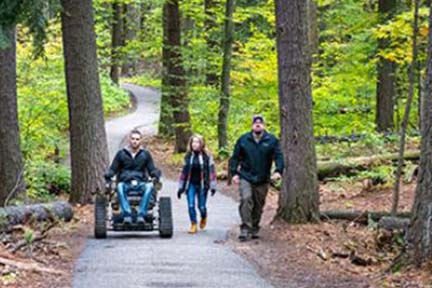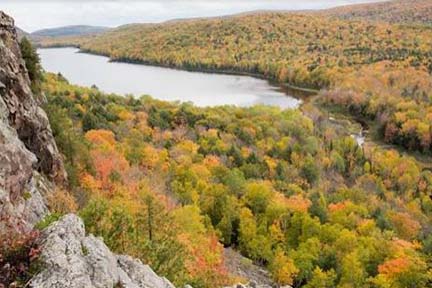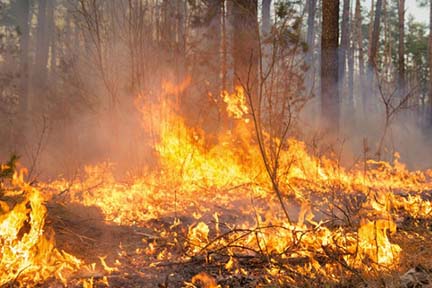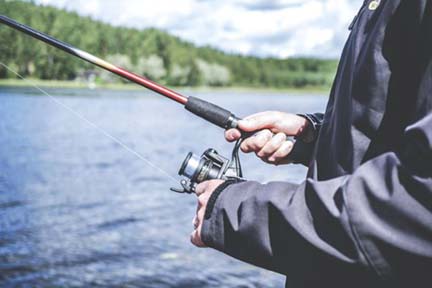| Here are a few of this week’s stories from the Michigan Department of Natural Resources:
See other news releases, Showcasing the DNR stories, photos and other resources at Michigan.gov/DNRPressRoom.
PHOTOS: Larger, higher-res versions of some of the images used in this email are available in the DNR’s public image gallery: pheasant hunting, native seed collection, fall forest, seedling planting and white-tailed deer.
 October means leaf-peeping, hunting and plenty of other fall fun, but did you know that October is Firewood Month? Michigan’s Invasive Species Program joins The Nature Conservancy to remind Michiganders to enjoy fall adventures but always leave firewood at home. October means leaf-peeping, hunting and plenty of other fall fun, but did you know that October is Firewood Month? Michigan’s Invasive Species Program joins The Nature Conservancy to remind Michiganders to enjoy fall adventures but always leave firewood at home.
Untreated firewood is a known carrier of invasive tree pests and diseases. That harmless-looking stack of logs in the backyard may be harboring spongy moth or spotted lanternfly egg masses, oak wilt fungus or beech bark disease. These and other tree-killing invaders don’t move far on their own, but they can travel hundreds of miles on infested firewood that is transported from place to place. |
Keep the fire burning
You can still have a roaring campfire or a cozy night in front of the fireplace if you know how to burn safe.
- Always leave your backyard firewood at home, even if you think it looks fine.
- Buy firewood near where you will burn it – choose wood that was cut within 50 miles of where you’ll have your fire.
- Use FirewoodScout.org to find a firewood vendor near your destination. With over 350 Michigan listings, you can comparison shop before you arrive.
- Certified, heat-treated firewood is safe to move long distances. Look for a federal stamp or seal on the package.
- If you buy firewood and don’t burn it all, don’t take leftover firewood home or to your next destination.
- Tell your friends not to bring wood with them; everyone needs to know they should not move firewood.
By choosing to purchase firewood at or near your destination, you avoid the risk of introducing harmful invasive species to the places you love. Your choice helps to protect the beautiful palette of fall colors and bountiful wildlife habitat that Michigan’s forests provide.
Get more information on invasive tree pests and diseases of concern at Michigan.gov/Invasives.
Questions? Contact Joanne Foreman at 517-284-5814.
 There are many ways you can help the DNR take care of Michigan’s natural and cultural resources; sometimes you just need to know where to start! Following are a few options to get involved this month; for more opportunities to volunteer, contribute and add your voice to the conversation, visit Michigan.gov/DNRVolunteers. There are many ways you can help the DNR take care of Michigan’s natural and cultural resources; sometimes you just need to know where to start! Following are a few options to get involved this month; for more opportunities to volunteer, contribute and add your voice to the conversation, visit Michigan.gov/DNRVolunteers.
Keep state parks healthy
Volunteer stewardship workdays are an excellent way to make a real difference at some of your favorite state parks in southern Michigan! You can help remove invasive plants that threaten high-quality ecosystems or collect native wildflower seeds for replanting. Opportunities this month include Oct. 12 and Oct. 20 at Fort Custer Recreation Area (Kalamazoo County) and Oct. 26 at Warren Dunes State Park (Berrien County).
Get more workday info and registration details on the DNR volunteer events calendar. |
Improve wildlife habitat
On the Ground, Michigan United Conservation Clubs’ volunteer wildlife habitat improvement program in partnership with the DNR, will host a tree planting event at Maple River State Game Area in Gratiot County Friday, Oct. 18, from 9:30 a.m. to 12:30 p.m. A mix of crabapple trees will be planted and fenced to improve food sources for wildlife including white-tailed deer. Lunch and an appreciation gift will be provided to all registered volunteers.
Find more details and registration info on the On the Ground webpage.
Give input on your state forests
 The next meeting of the Michigan Natural Resources Commission – Thursday, Oct. 10, in Marquette – leads off with updates on the new state forest management plan; deer habitat, nutrition and northern hardwoods; white-tailed deer predation in the Upper Peninsula; and the wolf abundance project. Later, there will be presentations on Bays de Noc walleye research and management and white-nose syndrome in bats. The next meeting of the Michigan Natural Resources Commission – Thursday, Oct. 10, in Marquette – leads off with updates on the new state forest management plan; deer habitat, nutrition and northern hardwoods; white-tailed deer predation in the Upper Peninsula; and the wolf abundance project. Later, there will be presentations on Bays de Noc walleye research and management and white-nose syndrome in bats.
The meeting starts at 9 a.m. in the Grand Ballroom of Northern Michigan University’s Northern Center, 1401 Presque Isle Ave. Before the meeting, at 8 a.m., the public is invited to enjoy Coffee with the Commissioners, an opportunity to speak with commission members in a less formal setting.
See the draft meeting agenda at Michigan.gov/NRC. For more information about the meeting, email NRC@Michigan.gov. |
 Michigan communities, utilities, and college, K-12 and healthcare campuses interested in earning a Tree City, Tree Line or Tree Campus USA designation are encouraged to apply or contact the DNR by the end of the year. Michigan communities, utilities, and college, K-12 and healthcare campuses interested in earning a Tree City, Tree Line or Tree Campus USA designation are encouraged to apply or contact the DNR by the end of the year.
These annual recognition programs are sponsored by the Arbor Day Foundation and administered by forestry agencies in each state. Applicants must meet criteria established by the foundation; this short quiz can help determine eligibility and readiness.
The Tree City USA program began in 1976 as a United States bicentennial project to promote tree planting in urban areas and call attention to the economic, health and aesthetic benefits trees provide.
Last year, 120 communities and 16 campuses in Michigan achieved their respective designations, and 11 communities earned Growth Awards for going above and beyond. Michigan ranks ninth among all states in total number of communities certified. They range in size from the village of Michiana (population 200) to the city of Detroit (population 620,376). |
Communities applying for Tree City USA certification must have met the following standards in 2024:
- Standard 1: Tree board or department responsible for public tree management.
- Standard 2: Public tree ordinance.
- Standard 3: Tree care program and annual budget of at least $2 per capita.
- Standard 4: Official Arbor Day proclamation and recorded Arbor Day celebration event.
Visit arborday.org/treecityusa for the application portal and materials and instructions on logging into the portal.
Online applications are encouraged. Paper applications may be sent to: DNR, Forest Management Division, P.O. Box 30452, Lansing, MI 48909. For questions about these programs or the DNR’s Urban and Community Forestry program, contact Lawrence Sobson at 313-316-4137.
 See more pictures by Michigan state parks photo ambassadors at Instagram.com/MiStateParks. For more on the program, call Stephanie Yancer at 989-274-6182. (This photo is by Karen Allmond, for the Michigan DNR, at Tawas Point State Park in Iosco County.) See more pictures by Michigan state parks photo ambassadors at Instagram.com/MiStateParks. For more on the program, call Stephanie Yancer at 989-274-6182. (This photo is by Karen Allmond, for the Michigan DNR, at Tawas Point State Park in Iosco County.)
|










